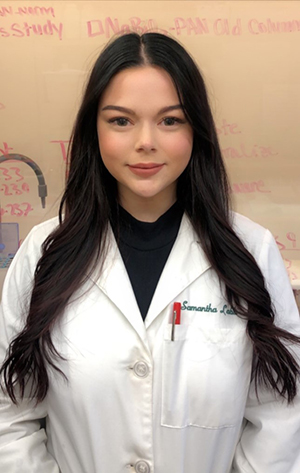News Archive
Written by Samantha Labb, Colorado State University
Edited by Jordan Noey, MSE, University of Michigan, HPS Student Support Committee

Samantha Labb
Submitted photo
The Student Support Committee is proud to showcase another outstanding health physics graduate student, Samantha Labb, who is a radiochemistry and health physics PhD student in the Department of Environmental and Radiological Health Sciences at Colorado State University (CSU). We hope you get to know Samantha as you learn about her background, internship experiences, and current PhD research.
Samantha is currently a fourth-year PhD student working under Dr. Ralf Sudowe, PhD. She obtained her bachelor’s in chemistry with a minor in mathematics from Salisbury University. During her undergraduate career, Samantha participated in organic and organometallic chemistry research and held positions as an organic and analytical chemistry lab assistant and a general chemistry teaching assistant. She also obtained a position as a quality assurance/quality control chemist at Evolution Craft Brewery, which gave her a glimpse of working in an industrial environment. During her undergraduate career, she developed a novel ligand for the separation of actinides from lanthanides in view of closing the nuclear fuel cycle. As a result, she gained a passion for radiochemical research that would advance nuclear science, leading to her pursual of a PhD in the nuclear field. During the summer between her undergraduate and graduate career, she was a senior research aide at Argonne National Laboratory, where she worked on recovering barium from strontium resin columns that would ultimately support the age-dating of cesium-137 sources.
Currently, she is exploring methods to separate americium (Am) in higher oxidation states from curium (Cm). This project explores the fundamental solution chemistry of these radionuclides and aims to develop a successful separation of the two. This research supports both the nuclear fuel cycle and stockpile stewardship. When applied to the nuclear fuel cycle, efficient separation is necessary for the partitioning and transmutation of these radionuclides to close the fuel cycle. In addition, this separation supports 241Am neutron capture cross section experiments. Obtaining more accurate nuclear data would improve computational simulations that help ensure the safety and reliability of the current weapons stockpile.
Currently, Samantha is a Seaborg Fellow at Los Alamos National Laboratory, where she is conducting her dissertation research in support of the weapons mission. She is also a recipient of the Health Physics Society’s Dade Moeller Scholarship and the American Nuclear Society’s James R. Vogt Radiochemistry Scholarship.
During her national laboratory internship and practicum experiences, she noticed there was a disconnect between radiochemists and health physicists. Samantha also noticed a disconnect between the scientific community and the public when it comes to the nuclear field. She realized that obtaining a PhD in both fields would give her the opportunity to bridge these gaps. It is her hope to utilize the knowledge gained at CSU to aide in more complete experimental development and introduce more efficient communication between the two fields and the public.
Samantha is expected to graduate in spring 2023. She looks forward to obtaining a postdoctoral appointment at a national laboratory. Samantha seeks to participate in projects that would allow her to contribute a greater understanding of the periodic table’s f-block elements while applying this knowledge to a variety of high-priority projects (e.g., forensics, weapons, medicine, and energy). Through the combination of her radiation protection and chemistry backgrounds, Samantha hopes to convey the importance of these technologies in a concise and effective manner.




